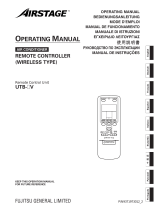
En-2
SAFETY PRECAUTIONS
SAFETY PRECAUTIONS ........................................En-2
FEATURES AND FUNCTIONS ...............................En-3
NAME OF PARTS ...................................................En-4
PREPARATION .......................................................En-6
OPERATION ............................................................En-7
TIMER OPERATION ...............................................En-9
SLEEP TIMER OPERATION .................................En-10
ADJUSTING THE DIRECTION OF
AIR CIRCULATION ............................................... En-11
AIR OUTLET SELECTION ....................................En-12
10°C HEAT OPERATION ......................................En-13
ECONOMY OPERATION ......................................En-13
SWING OPERATION ............................................En-14
MANUAL AUTO OPERATION ...............................En-14
CLEANING AND CARE .........................................En-15
TROUBLESHOOTING ..........................................En-17
OPERATING TIPS .................................................En-18
CONTENTS
PART No. 9378532069-02
OPERATING MANUAL
FLOOR TYPE
WARNING
●
This product contains no user-serviceable parts. Always consult au-
thorized service personnel for repairing, installation, and relocation
of this product.
Improper installation or handling will cause leakage, electric shock,
or fi re.
●
In the event of a malfunction such as burning smell, immediately
stop operation of the air conditioner, and disconnect all the power
supply by turning off the electrical breaker or disconnecting the
power plug. Then consult authorized service personnel.
●
Take care not to damage the power supply cable.
If it is damaged, it should only be replaced by authorized service
personnel.
●
In the event of refrigerant leakage, be sure to keep away from fi re
or any fl ammables, and consult authorized service personnel.
●
In the event of a thunder storm or any prior sign of a lightning strike,
turn off the air conditioner via the remote controller, and refrain from
touching the product or the power source to prevent any electrical
hazards.
●
This appliance is not intended for use by persons (including chil-
dren) with reduced physical, sensory or mental capabilities, or lack
of experience and knowledge, unless they have been given supervi-
sion or instruction concerning use of the appliance by a person
responsible for their safety. Children should be supervised to ensure
that they do not play with the appliance.
●
Do not start or stop the operation of this product by inserting or pull-
ing out the power plug, or by turning on or off the circuit breaker.
●
Do not use fl ammable gases near this product.
●
Do not expose yourself directly to the cooling airfl ow for many
hours.
●
Do not insert your fi ngers or any other objects into outlet port, open
panel, or intake grille.
●
Do not operate with wet hands.
CAUTION
●
Provide occasional ventilation during use.
●
Always operate this product with air fi lters installed.
●
Ensure that any electronic equipment is at least 1 m (40 in) away
from either the indoor unit or outdoor unit.
●
Disconnect all the power supply when you are not using this prod-
uct for extended periods.
●
After a long period of use, ensure to get the mounting of the indoor
unit checked to prevent this product from falling down.
●
The airfl ow direction and the room temperature should be care-
fully considered when you use this product in a room with infants,
children, elderly or sick persons.
●
Do not direct the airfl ow at fi replaces or heating apparatus.
●
Do not block or cover the inlet and outlet ports.
●
Do not apply any heavy pressure to radiator fi ns.
●
Do not climb on, place objects on, or hang objects from this prod-
uct.
●
Do not place any other electrical products or household belongings
under this product.
Dripping condensation from this product might get them wet, and
may cause damage or malfunction of your property.
●
Do not expose this product directly to water.
●
Do not use this product for preservation of food, plants, animals,
precision equipment, art work, or other objects. This may cause
quality deterioration of those items.
●
Do not expose animals or plants to the direct airfl ow.
●
Do not drink the drainage from the air conditioner.
●
Do not pull the power supply cable.
●
Do not touch the aluminum fi ns of heat exchanger built-in this prod-
uct to avoid personal injury when you maintain the unit.
●
To prevent personal injury, or property damage, read this section carefully before you use this product, and be sure to
comply with the following safety precautions.
●
Incorrect operation due to failure to follow the instructions may cause harm or damage, the seriousness of which is clas-
sifi ed as follows:
WARNING
This mark indicates procedures which, if improperly performed, might lead to the
death or serious injury of the user or service personnel.
CAUTION
This mark indicates procedures which, if improperly performed, might possibly re-
sult in personal harm to the user, or damage to property.



















